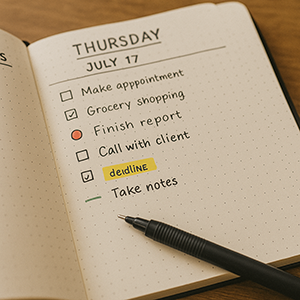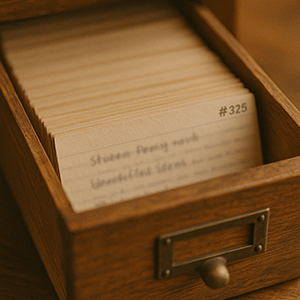At first glance, they might look similar:
Notebooks. Pens. Arrows and margins. Maybe a ruler if you're fancy.
But underneath the surface, the Slipbox and the Bullet Journal are solving two completely different problems.
So if you’ve ever wondered whether you should use one or the other—or both—this post will help you figure it out.
📘 The Bullet Journal: Organize the Now
Ryder Carroll’s Bullet Journal (or BuJo, if you’re cool) was created to help people track the present.
It’s a planner, a task manager, a habit tracker, and a reflection tool all rolled into one. Think of it as your daily dashboard.
Core features:
- Future log, monthly log, and daily log
- Rapid logging: bullets for tasks, events, and notes
- Migration to keep tasks from getting stale
The bullet journal is ideal if you want:
- To stay on top of daily life
- A flexible, analog task manager
- A little beauty and order in your chaos

🗂️ The Slipbox: Organize the Mind
The Slipbox (or Zettelkasten) isn’t about managing your to-do list.
It’s about thinking in depth over time.
Where the bullet journal helps you plan the week, the slipbox helps you develop ideas that might not come to fruition for years.
Core features:
- Atomic, permanent notes (one idea per card)
- Internal links between notes
- A system that evolves with your thinking
The slipbox is ideal if you want:
- To think clearly, write deeply, or research long-term
- A system that grows as your knowledge grows
- A companion for writing, teaching, or creative work

🧠 Productivity vs. Thought Development
Let’s make it plain:
| Bullet Journal | Slipbox (Zettelkasten) | |
|---|---|---|
| Purpose | Manage life | Grow ideas |
| Time Scale | Days & weeks | Months & years |
| Structure | Logs and modules | Atomic notes + links |
| Medium | Bound notebook (usually) | Loose cards or digital slips |
| Primary Use | Productivity & reflection | Research, writing, synthesis |
There’s no need to choose sides—because the systems actually complement each other.
🔄 Using Both Together
Here’s a little secret:
Many serious thinkers use a bullet journal for planning and a slipbox for idea development.
Use the bullet journal to:
- Track fleeting ideas
- Set reminders to process reading
- Sketch out outlines for projects
Then use the slipbox to:
- Turn those ideas into lasting knowledge
- Link concepts together
- Build a long-term archive of your thinking

🏁 Final Thought
The Bullet Journal helps you handle the urgent.
The Slipbox helps you wrestle with the important.
One keeps the day moving. The other helps your ideas stand still long enough to grow.
They’re not rivals. They’re different tools for different jobs—and together, they’re a powerful analog combo.
